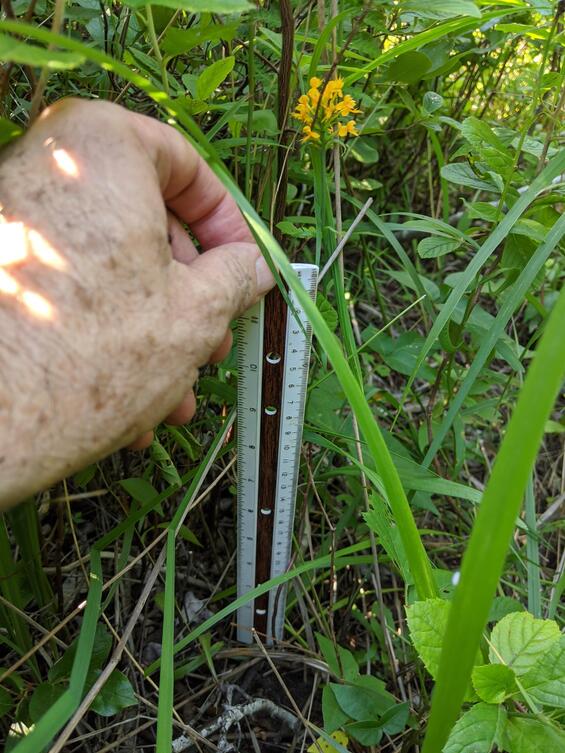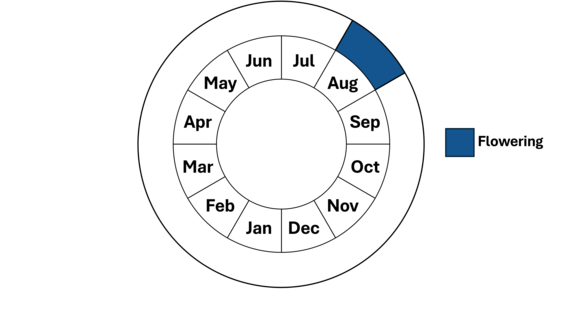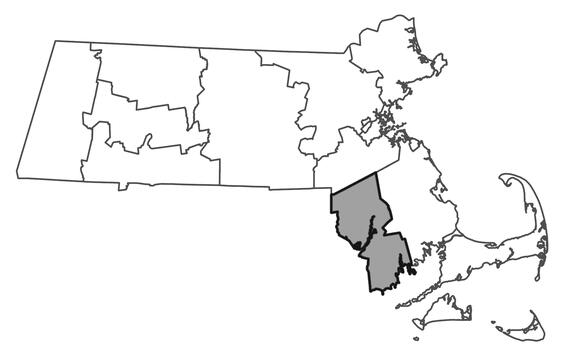- Scientific name: Platanthera cristata
- Species of Greatest Conservation Need (MA State Wildlife Action Plan)
- Endangered (MA Endangered Species Act)
Description

Crested Fringed Orchid. Image by Robert Wernerehl.
Crested fringed orchid is a wand-like, hairless plant with fleshy roots, measuring 12-24 inches (30-60 cm) tall. The two to four lower stem leaves are narrow (01-2.5 cm wide; 4-1 in), long (7-21 cm, 2.8-8.4 in), and pointed. The upper leaves are much smaller than the lower leaves and tend to hug the stem. The flower cluster (inflorescence) is compact, measuring 3-12 cm (1.2-4.7 in) long and about 3 cm (1.2 in) in diameter. The inflorescence is densely flowered and forms a spike-like raceme with as many as eighty small orange flowers per inflorescence. Petals are shallowly fringed around the margin and project over the sepals. The spur, an elongated structure containing nectar, is very short and slender. The flowering season in Massachusetts is throughout the month of August.
The white fringed orchid (P. blephariglottis) has a flower similar to the crested fringed orchid except in color. The orange fringed orchid (P. ciliaris) is larger than the crested fringed orchid and has a broader, less compact, and often proportionately shorter raceme of flowers. The flowers of the orange fringed orchid may be greater than twice the size of the flowers of the crested fringed orchid and are much more deeply fringed.
Life cycle and behavior
This is a perennial species.

Population status
Crested fringed orchid is listed as endangered in Massachusetts. The Natural Heritage & Endangered Species Program has 3 records from 1 county: Bristol. One of these records has been observed within the last 25 years. The crested fringed orchid is also considered rare in Arkansas, Delaware, Florida, Georgia, Kentucky, Maryland, Mississippi, New Jersey, New York, and Virginia. The species is presumed to be extirpated from Pennsylvania. Probable threats to the orchid include competition from the overgrowth of shrubs and disturbance from pedestrian traffic.
Distribution and abundance
Crested fringed orchid is found from southeastern Massachusetts to Tennessee and Arkansas, south to central Florida and along the Gulf Coast to Texas. Massachusetts is at the very northeastern tip of the range.

Distribution in Massachusetts. 1999-2024. Based on records in the Natural Heritage Database.
Habitat
Crested fringed orchid is usually found in moist acidic soil in bogs, wet meadows, swamps, and depressions in pinelands. The one verified occurrence in Massachusetts is found in narrow sedge-grass wetlands in stabilized dunes. Surrounding prominent plants include rushes, irises, cross-leaved milkwort, goldenrods, and marsh fern. Others include asters, slough grass, cranberry, and Canada reed grass. Typical shrubs of the surrounding edge are swamp azalea, viburnum, maleberry, and sheep laurel.
Healthy habitats are vital for supporting native wildlife and plants. Explore habitats and learn about conservation and restoration in Massachusetts.
Threats
The one active site is very close to the ocean and therefore is threatened by shoreline development, coastal erosion, and sea-level rise which is expected to continue as the climate warms. Temperature and seasonality changes caused by climate warming may also disrupt synchronization of pollinators to plant flowering. In the Northeast US, sea level has risen about 12 inches since the year 1900, faster than the rate around the world (Staudinger et al. 2024).
The dust-like seeds of orchids rely on mycorrhizae for seed germination, protocorm formation and seedling growth. Therefore, it is quite likely that changes in species composition and abundance of mycorrhizae will strongly affect orchids over time. Causes of orchid decline could include, but are not limited to, deer herbivory (Knapp and Wiegand 2014), earthworms (McCormick et at. 2013), lack of disturbance (Sheviak 1990), nitrogen deposition (Figura et al. 2020, Whalen et al. 2018), invasive, non-native species such as garlic mustard (Anthony et al. 2017), and canopy closure (Brumback et al. 2011, Whigham et al. 2021), all of which affect orchids in Massachusetts (Frost 2023). Other specific threats include changes in climate, which might cause a disassociation with its pollinators. In Massachusetts, spraying for mosquito control can be common in the county where this occurs. The pollinator for this species is unknown and could be a mosquito or similar small flying insect that could be eliminated by mosquito control chemicals.
Conservation
Survey and monitoring
The one known location currently active grows in a dense thicket of shrubs interlaced with the sharp thorns of greenbriar, making monitoring of populations a bit more challenging that other species. Given the apparent decline in crested fringed orchid, much more de novo surveying is needed.
Management needs
Management needs include removal and control of any invasive species and avoidance of direct disturbance by any sort of land use change, or indirect disturbance by means of altered hydrology. This site may need prescribed fire.
Research needs
Research needs should be tailored to address threats, and also to see if this species can be propagated in a greenhouse for purposes of reintroduction into habitats where it was known to occur. This particular group of orchids has a number of species that respond well to prescribed fire. Use of fire on sites where this species was known to occur should be considered.
References
Anthony, M. A., S. D. Frey, and K. A. Stinson. 2017. Fungal community homogenization, shift in dominant trophic guild, and appearance of novel taxa with biotic invasion.
Brumback WE, Cairns S, Sperduto MB, Fyler CW (2011) Response of an Isotria medeoloides Population to Canopy Thinning. Northeastern Naturalist 18:185–196. https://doi.org/10.1656/045.018.0205
Figura T, Weiser M, Ponert J (2020) Orchid seed sensitivity to nitrate reflects habitat preferences and soil nitrate content. Plant Biology 22:21–29. https://doi.org/10.1111/plb.13044
Knapp WM, Wiegand R (2014) Orchid (Orchidaceae) decline in the Catoctin Mountains, Frederick County, Maryland as documented by a long-term dataset. Biodivers Conserv 23:1965–1976. https://doi.org/10.1007/s10531-014-0698-2
McCormick MK, Parker KL, Szlavecz K, Whigham DF (2013) Native and exotic earthworms affect orchid seed loss. AoB PLANTS 5:plt018. https://doi.org/10.1093/aobpla/plt018
Sheviak CJ (1990) Biological considerations in the management of temperate terrestrial orchid habitats. New York State Museum Bulletin 471:194–196
Staudinger, M.D., A.V. Karmalkar, K. Terwilliger, K. Burgio, A. Lubeck, H. Higgins, T. Rice, T.L. Morelli, A. D'Amato. 2024. A regional synthesis of climate data to inform the 2025 State Wildlife Action Plans in the Northeast U.S. DOI Northeast Climate Adaptation Science Center Cooperator Report. 406 p. https://doi.org/10.21429/t352-9q86
Whalen, E. D., R. G. Smith, A. S. Grandy, and S. D. Frey. 2018. Manganese limitation as a mechanism for reduced decomposition in soils under atmospheric nitrogen deposition. Soil Biology and Biochemistry 127: 252–263.
Whigham D, McCormick M, Brooks H, et al (2021) Isotria medeoloides, a North American Threatened Orchid: Fungal Abundance May Be as Important as Light in Species Management. Plants 10:1924. https://doi.org/10.3390/plants10091924
Contact
| Date published: | May 12, 2025 |
|---|